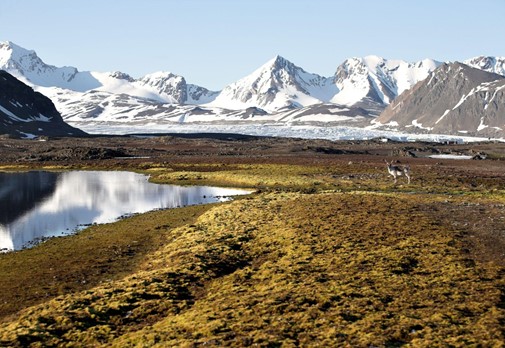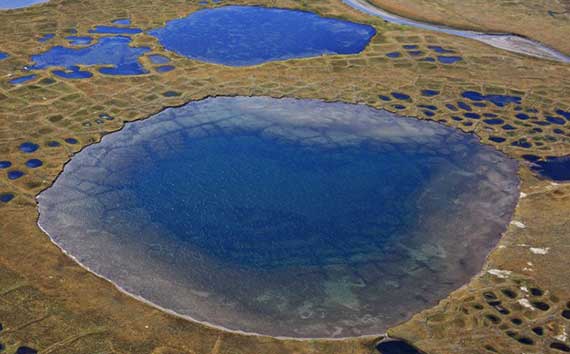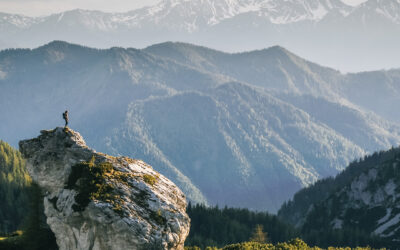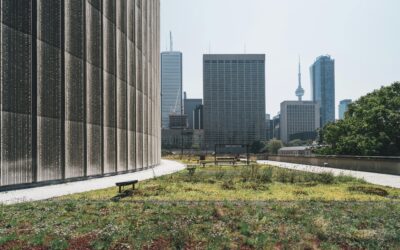Permafrost is a solid layer of ground ice that doesn’t melt for thousands of years in some instances. These regions primarily occupy the northern latitudes of our globe but are found anywhere the ground temperature remains cold enough to stay frozen year-round. But what happens when permafrost starts melting? While most people associate global warming with melting sea ice, permafrost should also be considered.
Unfortunately, we have to face this question today as a warming arctic threatens the status of long-frozen soil layers. The preservation of permafrost protects polar ecosystems, reduces carbon emissions, and provides scientists with rich material to study. But, when global air temperatures rise, permafrost can turn into a carbon dioxide emitter, release viruses and bacteria, and discharge mercury into our waterways and oceans.
We’ll cover the importance of permafrost and how it contributes to the state of the global climate and ecosystem.
What Is Permafrost?
Permafrost is a layer of the Earth’s soil that is constantly frozen. The frozen layer can occur at the surface or under a non-frozen layer of soil. Permafrost is also found under bodies of water, like lakes or oceans. It consists of soil, gravel, rocks, and sand held together with ice throughout the year.
Permafrost covers about 8.8 million square miles of land in the Northern Hemisphere. The thickness of its layers are anywhere from 3 feet thick to over 3,000 feet thick. Permafrost is caused when groundwater trapped in soil and rocks is exposed to sub-freezing temperatures most of the year and occurs in regions like the arctic tundra or high-altitude mountainous regions.
For frozen ground to be considered permafrost, it must remain frozen for two consecutive years. Many regions around the world have ground that freezes for part of the year, but permafrost is unique in that it is frozen even through the summer months.
While two years is the minimum for permafrost consideration, some regions have had frozen ground for hundreds of thousands of years. Scientists discovered the oldest known permafrost in Siberia, which has been frozen for the past 650,000 years.
Where Is Permafrost Found?
Permafrost is present around the globe in different concentrations depending on the region’s geographic features and climate. It can be found in many areas where the average temperature remains cold enough for ice to stay solid all year. Below, we’ll look into where you can find permafrost around the world, including which countries have the most permafrost landscapes.
Permafrost is found in the Northern Hemisphere and the Southern Hemisphere but is more predominant in the northern half of the globe. There is a higher concentration of permafrost in the Northern Hemisphere due to the greater land area found there. The Southern Hemisphere has more oceans and less land that can freeze and become permafrost.
In the Northern Hemisphere, 24% of the land has permafrost underneath it. On the southern half of the globe, permafrost is found in the high-alpine regions of Patagonia and New Zealand. It is also found in the 0.3% of Antarctica that is not covered with ice sheets. Scientists believe there may be permafrost beneath the ice sheets, but it is difficult to study because the Antarctic ice sheets are thousands of feet thick in some areas.
Permafrost is found most in Arctic tundra landscapes. Canada, Alaska, Greenland, Siberia, and Eastern Europe are covered in tundra that have high concentrations of ground that is frozen year-round. For example, 85% of Alaskan land is covered in permafrost. Russia has more permafrost than any other country, with two-thirds of its land area having frozen soil layers that last year-round.
High-alpine places also have permafrost. Regions where the altitude keeps the average temperature low enough can have ground that remains frozen. Examples of these places include the Tibetan Plateau in Asia and the Colorado Rockies in the United States.
Why Is Permafrost Important?
From playing an essential role in polar ecosystems to slowing the rate at which climate change occurs, permafrost holds a large part in global climate conditions. However, it’s not only the climate that permafrost affects. It also acts as an incredible resource for scientists to understand Earth’s biological history. Plus, it provides a reference point for climate scientists to study and make predictions about global climate trends.
Let’s take a look at how important frozen ground really is.
Protecting Tundra Ecosystems
Permafrost creates the foundation for tundra ecosystems. It contributes to freeze-thaw cycles that the plants and animals of the arctic have come to rely on. Its presence inhibits the growth of many plant species, save for the ones that have evolved to grow in harsh conditions. The permafrost creates a steady and predictable environment for tundra life to flourish. Protecting permafrost can go a long way toward preserving Earth’s biodiversity.
During the warm summer months, the top layer of soil melts, but the permafrost remains beneath and traps water near the surface. The trapped water creates shallow lakes and bogs that teem with life. Migratory birds and insects take advantage of the unique tundra wetlands that form during the summer.
As permafrost thaws due to climate change, the tundra ecosystem is experiencing rapid change. Plant and animal species that are not native to tundra lands have begun to venture further north, creating increased competition in the ecosystem. Plus, the absence of permafrost can cause the landscape to change dramatically, creating land erosion and the disappearance of lakes.
Preventing Global Warming
Permafrost and the tundra landscapes it creates is one of Earth’s methods for reducing the amount of carbon in the atmosphere. Permafrost stops the decay of plant matter, which reduces the number of greenhouse gases released each year. Around half of the world’s organic carbon soil is found in tundra landscapes.
Dead plant matter in other biomes is consumed by microbes during the process of decay. The byproduct of decay is carbon dioxide and methane released by these microbes. Permafrost shelters plant and animal matter from decay, preventing greenhouse gases from being released.
However, as more permafrost melts, more organic matter is exposed to decay. This means tundra landscapes that once acted as a carbon sink are now acting as carbon contributors.
Providing Access to Biological History
Permafrost provides scientists with the opportunity to look into the Earth’s biological past. The frozen layers of sediment preserve plants and animals of the past and give scientists the opportunity to observe specimens that have experienced very little decay. Permafrost does such an excellent job of preventing decay that even DNA has been preserved and collected by scientists in specimen and soil samples.
One of the fascinating preserved ice age animals found in North America includes a wolf pup that was completely intact, save for its eyes. Evidence of western camels, arctic hyenas, and scimitar cats have also been found in North America. In Siberia, a 28,000-year-old cave lion cub was found with its whiskers still intact, and a 39,000-year-old woolly mammoth was well-preserved enough to extract flowing blood from.
Presenting Scientists With Climate Data
Another important role permafrost plays is that it provides climatologists a point of reference from which they can make observations about temperature changes in arctic regions. Because the tundra landscape of the arctic is so dependent on permafrost, the changes to the landscape are easy to observe as the frozen earth melts away.
The diminishing permafrost allows scientists to gather information on the effects our planet faces due to climate change. From this information, we can learn ways to prevent loss of permafrost and tundra landscapes.
Is Permafrost Melting?
Arctic permafrost is melting due to increasing global temperatures, and it is expected that up to two-thirds of the permafrost near the surface could be lost by 2100. The evidence of permafrost thaws is apparent and includes disappearing lakes and changes to the shape of the landscape.
When permafrost melts away, there is nothing to stop the water draining from the lakes in the region. The lakes that form in the tundra remain full because the permafrost ice under them creates a barrier that water cannot pass through. But, as permafrost continues to erode, underground drainages become larger, and scientists have started to observe the disappearance of lakes that, in some cases, are multiple square miles in size.
Other evidence of melting permafrost include dramatic changes to the landscape. Hillsides have become unstable, and landslides of soil and plants are beginning to give way without the permafrost there to support them. With warmer and longer summers occurring in the arctic, the number of observed land surfaces alterations have increased 300% in the past two decades due to the loss of permafrost.
The rate at which permafrost melts has been affected by an increase of wildfires in the arctic. As the permafrost melts, the plants in the region become drier as surface water levels diminish. Wildfires are then more likely to occur. The wildfires themselves then contribute to the loss of permafrost, adding to the cycle in a feedback loop.
What Are the Three Risks Associated With Permafrost Thaw?
There are a number of risks associated with thawing permafrost. Of all the negative consequences, though, there are three that have the potential to be most devastating to the entire planet.
The first is increasing climate change as more carbon dioxide and methane are released due to organic matter decay. The second is the potential for releasing bacteria and viruses that plagued the world long ago and could spread again once thawed. Last, there is evidence to support an increase in heavy metals in the arctic food chain as a result of the thawing of permafrost.
Let’s look into each of these risks associated with thawing permafrost.
Contributing to Global Warming
Permafrost regions typically have a top layer that melts during the summer months. This layer is known as the active layer and is the part of the land that supports life when it is warm enough. The plants that grow in the active layer eventually die, and the remains end up in the soil.
Unlike other areas of the world, though, these remains are not decomposed because it is too cold for microbes to break down the organic material. So, in areas where there is permafrost, much of the soil has plant matter that is full of carbon, ready to get broken down once it thaws out.
Now that global warming has caused permafrost to melt, all the plant matter in the soil is ready for microbes to begin their decomposition work. As the microbes decompose all the carbon-rich matter, they emit carbon dioxide or methane into the atmosphere. The increase in these greenhouse gases then causes more warming and more permafrost melting, resulting in a feedback loop that isn’t good for the state of permafrost or the global temperature.
Releasing Bacteria and Viruses
As the permafrost gives way, it is like opening up a time capsule to the past. That past can include undiscovered viruses and antibiotic-resistant bacteria. As the permafrost melts away, these pathogens can enter the water runoff and become active.
Over 100 different antibiotic-resistant microorganisms were found in Siberia’s deep permafrost layers. As many of these bacteria and viruses are not well-studied, there are questions surrounding what the impacts could be if they were introduced into the modern ecosystem.
An anthrax outbreak occurred in Siberia as a result of melting permafrost. It infected reindeer and people living in remote Siberia. This anthrax outbreak is an example of the risks associated with bacteria and viruses thawing out of the permafrost ice.
Exposing Food Chains to Heavy Metals
The permafrost in the arctic has over 15 million gallons of mercury, accounting for more than twice as much mercury found in the rest of the world’s soil, oceans, and atmosphere combined. As the permafrost regions continue to melt, this mercury is released into waterways and eventually the ocean, where it has the potential to contaminate ecosystems around the world.
Mercury can cause health issues in the nervous system and vital organs. If mercury concentrations spike in fish stocks, animals higher up the food chain are likely to become exposed to the metal.
How Can We Stop Permafrost From Thawing?
The best way to stop permafrost from thawing is for the whole world to take action against climate change. Melting permafrost is a product of global warming, which is a worldwide issue. If the world comes together to fight the changing climate, we can slow the rate at which permafrost is thawing.
Countries around the world must focus on limiting their carbon footprint by switching from fossil fuels to renewable energy sources. Options like carbon finance systems incentivize businesses and governments to reduce their annual emissions.
It’s not just up to governments, though. Each individual plays an essential role in slowing climate change. You can take action in your daily life to limit your personal carbon footprint. Remaining conscious of how much energy you use for your home or business goes a long way in reducing emissions. You can also look into effective carbon offsetting programs designed to reduce the carbon footprint of your activities.
Permafrost Is Deserving of Protection
It’s amazing to think what a pivotal role frozen soil can play in the state of Earth’s climate and global ecosystem. Permafrost, if kept in its proper frozen state, is a huge benefit to the planet and to humankind. It protects delicate tundra ecosystems and prevents excessive amounts of carbon from entering the atmosphere. All the while, it provides scientists the ability to look into Earth’s biological past and draw conclusions about the future of our planet.
It’s essential that we protect permafrost to avoid furthering the negative impacts of global warming and exposing our planet to viruses, bacteria, and mercury. Together, we can prevent permafrost from melting as long as we do our part in reducing global warming.
Learn how you can protect Earth’s environments with Terrapass’ carbon offsetting solutions.
Brought to you by terrapass.com
Featured image:













